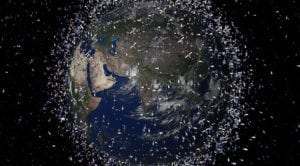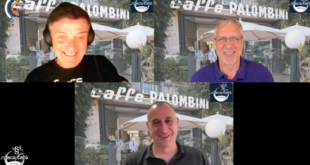by Dr. Darren McKnight, Centauri

Space traffic management (STM) is an enabler for reliable, safe space operations – the real objective that the global space community needs to rally around during this unprecedented growth of space system deployments and growth in orbital debris. [See Endnote 1] In developing STM solutions, do not get lost in a flurry of decrees about common data repositories and data transparency; we need to use clear, simple English. The requirement for STM is simply to avoid collisions.
There are two types of collisions that must be minimized or eliminated.
(1) Collisions that terminate the mission of an operational space system should be guarded against. These collisions come from both cataloged objects (greater than 10 cm in diameter in low Earth orbit, LEO) and lethal nontrackable (LNT) orbital debris fragments that currently are not in any publicly-available catalog due to their small size (objects between 1-10 cm in diameter). It is important to note that collisions with LNT account for over 95% of the mission-terminating debris collision risk in LEO. Collisions can be avoided with objects large enough to be tracked if the operational space system has both a collision avoidance capability and is provided actionable information with sufficient lead time. This process becomes slightly more complicated if both objects involved in an imminent very close approach are operational and capable of maneuvering. Conversely, the collision risk from LNT can only be managed now by preventing the creation of more LNT from massive derelict objects colliding (that is the second type of collision that must be avoided).
(2) Collisions between two large non-functional objects (e.g., abandoned rocket bodies or nonoperational payloads) must be reduced or eliminated since these may create large amounts of both cataloged and LNT debris that could in turn terminate the mission of an operational space system upon impact.
So, those are the types of collisions that need to be avoided; what should we do in pursuit of these goals?
Effective STM should (1) minimize the burden of collision avoidance maneuvers (i.e., reduce the number of unnecessary maneuvers), (2) reduce the probability that a collision will occur after a maneuver has been performed, and (3) eliminate the possibility that a collision would occur that was not predicted to occur. All of these start with more accurate conjunction data that is communicated to both parties (if both objects are operational satellites) in an operationally-relevant timeframe. This timeframe is a function of both the type/quality of the propulsion system used for the maneuver and the accuracy of the conjunction data.
The utility of a conjunction assessment is not improved by aggregating more data; in reality, the final result is as accurate as the least accurate data provided so more data may make the result less accurate and slow down delivery to the operator(s). As a result, the goal should be real-time traceability from the state vector measurement (i.e., initial description of an object’s position and velocity in space) propagated to the time of closest approach (TCA) with another object then communicated to the both operators so action can be taken to reduce the collision risk through collaborative operations.
The accuracy of any conjunction can be improved by enhancing three factors:
(1) improving the quality of the initial measurement (i.e., quantify and minimize the uncertainty),
(2) propagating the state vector forward as accurately as possible (function of both rigorous mathematical orbit propagators and refining object characterization such as area-to-mass ratio, tumbling, etc.), and
(3) minimizing the time of propagation (i.e., take quality measurements more often; for LEO, this can only be done by having more ground-based radars).
The simple mathematical truth is that accurate data taken more often (i.e., reduce propagation times to conjunction) will both enhance STM as well as refine debris remediation priorities (i.e., identify best objects for active debris removal, ADR). More data is better only when it directly improves the accuracy of a conjunction prediction and does not degrade the timeliness of the delivery of the data.
What really needs to happen is to both decrease the size of the objects that can be reliably sensed and increase the number of radars supporting these measurements. An S-band radar, as deployed by both the US Government and LeoLabs, can detect most LNT objects (i.e., down to ~2 cm) so this is a great start at getting more of the relevant data collected. However, in addition, only a global network of radars will reduce the propagation time (e.g., from daily to less than an hour) for all LEO objects to significantly improve conjunction accuracy. These improvements coupled with a web-enabled data platform that sends the data directly to the operators in the format they require both reduces the number of false collision warning directives while improving the absolute accuracy of the miss distances.
Forget the trite claims that all data should be democratized and available to all. That is an outstanding approach for a space catalog of objects where combining information provided to the United Nations to register the objects launched into space; open source information on the manufacture pedigree, mission, and intended use; radio frequency emissions related to operational activities; and orbital elements provided by ground-based observations can create a rich database that could serve as a globally-accepted description of the space population. This product benefits from a common data repository by meshing disparate qualitative and quantitative data into a rich depiction of space objects useful for research, analysis, policy formulation, etc.
However, for STM, we must focus on accuracy and timeliness; do not overcomplicate this process by trying to create a “one size fits all” solution. Instead, encourage conjunction data service providers worldwide to tailor the conjunction data delivery to operators to maximize space safety. These providers should use data and delivery standards as developed by the International Organization for Standardization (ISO) or similar entity.
It must be an international solution for an international challenge.
STM is simple but not easy; while data sharing is an obvious need to enable STM, the best ways to improve STM utility are very capital-intensive (i.e., better and more radars) which will require strategic investments by forward-thinking organizations.
Endnote 1: It should be noted that in addition to advancements in STM, there are two other critical areas that must also be refined and rejuvenated to support reliable, safe space operations globally: (1) Space systems and mission design must strive to create reliable space systems and resilient architectures in which they operate. Improvements to STM can be quickly nullified if space systems fail early and often in the execution of their missions. (2) More stringent debris mitigation guidelines and an initiation of active debris removal missions are necessary to minimize the events with the greatest debris-generating potential. The collision between two massive derelicts have the potential to add upwards of 10,000 to 15,000 cataloged fragments (i.e., nearly double the existing population) and 150,000 to 200,000 LNT.

Dr. Darren McKnight is currently Technical Director for Centauri based in Chantilly, Virginia. He leads teams to develop solutions across disparate domains: space safety, evolution of global space technologies, predictive awareness for infectious disease outbreaks, and orbital debris. He is an active member of the International Academy of Astronautics’ Space Debris Committee and co-chair of the International Astronautical Federation’s working group on Space Traffic Management. He has coauthored five books ranging from space debris and spacecraft operations to soccer coaching and innovation. Darren has authored over 100 technical papers and presented them in 19 countries.





